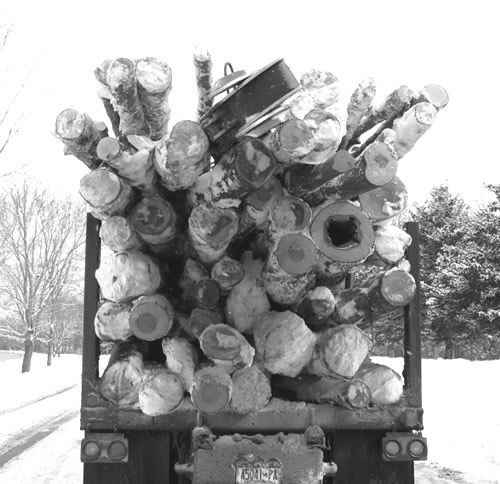Review Questions - Click On The Picture To Begin...

- A vertical barrier placed directly behind the cab of a tractor to protect the cab in the event cargo should shift forward.
- A vertical barrier across the front of the deck of a vehicle to prevent forward movement of cargo.
- A structure, device, or another substantial article placed against or around an article to prevent horizontal movement of the article.
- A vertical barrier across a vehicle to prevent forward movement of cargo.
Quote From The CDL Manual:
Bulkhead:
A vertical barrier across a vehicle to prevent forward movement of cargo.
- Right after it is cut down.
- When it is embedded in a stack of longwood.
- When it is painted green on the ends.
- When it is stacked long-ways on the trailer.
Quote From The CDL Manual:
What's in a stack?

Some stacks may be made up of both shortwood and longwood. Any stack that includes shortwood must follow the shortwood securement requirements.
Exception: If shortwood is embedded in load of longwood, it can be treated as longwood.
- A rail along the side of a vehicle that protects the side of the vehicle from impacts.
- A female housing fixed to the side or ends of a vehicle to receive a stake or peg, and may also be used as an anchor point.
- A device placed between the deck of a vehicle and car or between articles of cargo, intended to provide greater friction than exists naturally between these surfaces.
- The depression formed between two cylindrical articles when they are laid with their eyes horizontal and parallel against each other.
Quote From The CDL Manual:
Well:
The depression formed between two cylindrical articles when they are laid with their eyes horizontal and parallel against each other.
- The width of the road.
- 75 in
- 16 ft
- Half the length of the trailer.
Quote From The CDL Manual:
Shortwood
- Normally up to about 2.5 m (100 in) in length.
- No longer than 4.9 m (16 ft) in length.
-
Also called:
- Cut-up logs
- Cut-to-length logs
- Bolts
- Pulpwood
- Loads of no more than four processed logs.
- Firewood, stumps, debris, other short logs, and longer logs.
- Logs unitized by banding or other comparable means.
- All of these can be handled according to general cargo securement rules.
Quote From The CDL Manual:
Exceptions to the specific requirements
The following types of logs are not covered by the specific logs requirements:
- Logs unitized by banding or other comparable means. [Secure according to general cargo securement requirements.]
- Loads of no more than four processed logs. [Secure according to general cargo securement requirements.]
- Firewood, stumps, debris, other short logs, and longer logs. [Transport in a vehicle or container enclosed on both sides, the front, and the rear and strong enough to contain them.]
- It depends on if you are hauling shortwood or longwood
- 1,800 lb
- 50% of cargo weight
- 4,000 lb
Quote From The CDL Manual:
- Use tiedowns in combination with bunks, stakes, or standards and bolsters to secure the load.
- All tiedowns must have a working load limit not less than 1,800 kg (4,000 lb.).
- Tension tiedowns as tightly as possible but not beyond their working load limit.
- A reusable, transportable enclosure that is especially designed with integral locking devices that secure it to a container chassis trailer to facilitate the efficient and bulk shipping and transfer of goods by, or between various modes of transport, such as highway, rail, sea, and air.
- A specialized container, primarily used to contain and transport materials in the waste, recycling, construction/demolition, and scrap industries, which are used in conjunction with specialized vehicles, in which the container isloaded and unloaded onto a tilt frame body by an articulating hook-arm.
- A vehicle especially built and fitted with locking devices for the transport of intermodal containers.
- The load carrying area of a truck, trailer, or intermodal container.
Quote From The CDL Manual:
Hook-lift Container:
A specialized container, primarily used to contain and transport materials in the waste, recycling, construction/demolition, and scrap industries, which are used in conjunction with specialized vehicles, in which the container isloaded and unloaded onto a tilt frame body by an articulating hook-arm.




 Related Cargo Securement Terms That Every Driver Should Know:
Related Cargo Securement Terms That Every Driver Should Know: 



 TT On Facebook
TT On Facebook